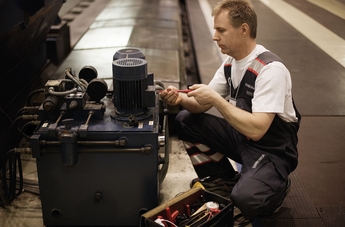There are crane companys in the US which employ some of the very best service technicians in the world, but others don’t follow their example.

I speak from experience, having started working with overhead cranes in 1978, when I begun an apprenticeship as an industrial electrician at a cast iron pipe manufacturing facility. The company had the very lowest regard for safety when it came to EOT cranes.
In fact, the Federal Government sent several of their managers to prison for dumping hazardous waste into streams that ran close to several of their plants, such was their lackadaisical approach to good practice.
The cranes at the Birmingham, Alabama plant (where I was employed for six years) were, put simply, unsafe. Not a crane in the plant, even those that carried hot metal, met the mandatory 8:1 safety factor. Not that management cared.
In a somewhat roundabout way, it taught me the importance of safety and the dangers posed by the use of overhead lifting equipment.
After six long years of accident after accident I was able to move onto better employment, and my crane education really begun. In my new role, being an on-site electrician ment that when anything happened to the overhead cranes, my team and I were responsible. All work on the cranes was was done internally as there were no service firms.
During my four years at this mill I never saw a contractor step foot on any overhead crane. No matter what the problem – wheel bearing failure, wire rope replacements, gear box failures, upgrades – it was all performed by the electricians. Occasionally we did get help from the mechnical guys, but it was rare.
As time went on I met and worked with several similar service technicians who, like me, had started out as electricians. The quality of service on offer was generally high, but it wasn’t long before a number of high profile manufacturers infiltrated the market with new kit, which we couldn’t always decipher.
It is widely accepted that several manufacturers strategically design and install their hoists and cranes with electronics and solid state controls that can only be serviced and maintained by their own technicians.
This switch in responsibility has been carefully orchestrated by these manufacturers and end users are at their mercy.
In my experience, performing a semi-annual inspection on a 30 US ton top running double girder with dual hoist and trolley with hoist took eight hours. We changed the oil on every gearbox, every contact tip was checked and the brakes were checked and double checked.
During the course of the inspection, every bolt or rail clip got a good kick to ensure they were tight and tie back plates were checked at every column line. There were two worn out service technicians at the end of each inspection.
The service on offer these days from a lot of companies is not as comprehensive and that needs to be addressed.
Rick Wall
Alabama Crane & Electrical Service, LLC
Please keep sending in your blogs from industry. What have you lifted recently? Just bought an interesting crane? Tell me how business is where you’re reading Hoist. Speaking of which, do you like it? What would you like to see us writing about?
Richard Howes, Editor
rhowes@progressivemediagroup.com






